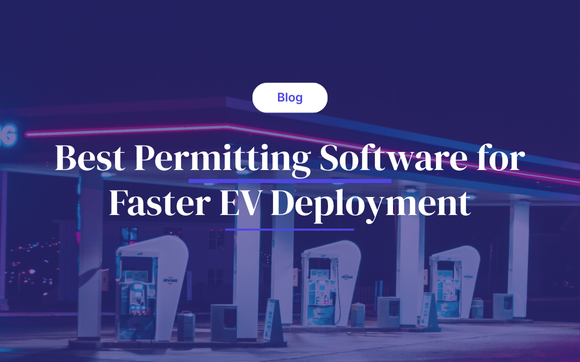5 Critical Questions You Should Ask to Avoid EV Permitting Delays

The EV gold rush is on. Global sales are surging, public charging ports are multiplying, and EV Charge Point Operators (CPOs) are racing to secure prime sites at transit hubs, grocery stores, office parks, restaurants…even your local Waffle House.
But with so many possible locations to vet, speed without strategy can lead to costly setbacks.
Permitting considerations should be part of site selection from the start to avoid weeks or months of delays down the road. The most successful CPOs ask the right questions upfront to keep timelines tight, budgets intact, and projects moving.
Here are five critical questions to ask before leasing a charging site:
How is the site zoned and what does that mean for EV charging installation?
Zoning is often the first gate to clear, and it’s rarely straightforward. Cities and counties divide land into zones with specific rules that regulate what can (and can’t) be built there. While some jurisdictions now classify chargers as public utilities or primary use cases, others treat them as accessory uses or don’t define them at all.
Even in areas with updated EV-friendly codes, a seemingly perfect site may require additional approvals—conditional use permits, zoning variances, or public hearings—which can trigger lengthy and unpredictable review processes. In rare cases, zoning may prohibit the project entirely.
This is why zoning isn’t something to check on after the fact. And it’s not enough to glance at a zoning map. Getting clear on zoning from day one can save you months of rework and help you prepare for what’s ahead. Ask these questions before you sign a lease:
- What’s the site’s current zoning designation?
- How does the local code define EV charging uses? Is it a primary use, accessory use, or undefined?
- Are there any zoning overlays, conditional use requirements, or special districts that could complicate permitting?
Has this jurisdiction permitted EV charging projects before…and what was required?
Permitting is hyper-local, and the range of EV permitting experience each city has is wide.
One jurisdiction might have a well-worn process for EV chargers, while the town next door is seeing its very first application cross the desk. Many will be unfamiliar with the infrastructure you’re trying to build.
Knowing the jurisdiction’s permitting history can help you gauge what kind of process you’re stepping into, and it is one of the clearest indicators of how predictable the project timeline will be. If the path is well-trodden, you’ll likely benefit from established templates and processes to follow. If not, you may need to build in extra time for collaboration. Ask these questions ahead of time:
- Has this jurisdiction permitted EV charging projects before? If yes, what was required for approval?
- Is there an EV-specific permitting guide, checklist, or fast-track program?
- What are the typical timelines and documentation requirements?
Does the site have enough utility capacity for EV chargers?
Securing power is just as critical as securing the land. Even if the site seems ready, the available utility capacity may not be sufficient for commercial EV charger installation. And upgrades can take many months, sometimes stretching timelines far beyond what teams expect.
It’s also essential to remember that utility approvals and upgrades move on a completely separate track from jurisdiction permitting, and utility schedules are typically far less flexible. Clearing permits doesn’t mean utility work is ready.
Engage utilities as early as possible and push for clarity on what their process and typical timelines look like. Use these questions as conversation starters:
- What power capacity is available at the site?
- Will we need new service panels or infrastructure upgrades?
- What’s the typical lead time for service installations or upgrades in this area?
Flipturn enables smarter utility management through software. Learn more in this episode of Permission to Build with co-founder Katie Siegel.
Are there any environmental or site-specific risks that could delay EV permitting?
Environmental factors like stormwater management, tree removal restrictions, or proximity to protected areas (such as schools, wetlands, or historic sites) often trigger additional reviews.
To catch these risks early, review publicly available records and conduct a thorough site walk to assess potential physical challenges like steep slopes, limited access points, or shared driveways. Digital tools like FEMA flood maps, local GIS portals, or RIMS/eco mapping systems can help surface environmental constraints and overlays before your team ever steps on site.
Doing this work upfront helps you flag potential hurdles, as well as build community trust and strengthen stakeholder buy-in, especially in residential areas or scenic corridors where concerns around traffic, aesthetics, or environmental impact can be more pronounced. Ask these questions on your next on-site:
- Are there any environmental, historical, or school-related overlays on or near the site?
- Is the site close to protected areas or other sensitive land uses?
- Are there physical features that could complicate construction?
Are we aligned on permitting workflows and responsibilities?
Internal misalignment can slow you down as much as an understaffed city office, and these issues often surface late, compounding external delays. Many CPOs still track permitting tasks through scattered spreadsheets, shared drives, inconsistent versioning, and long email chains, which makes it easy to miss deadlines or make avoidable mistakes.
When teams aren’t clear on who’s handling what, whether it’s jurisdiction outreach, utility coordination, or document submissions, tasks easily fall through the cracks. Consider using construction permitting software to streamline all tasks and steps in one unified system, replacing disorganized spreadsheets with organized, trackable workflows. Kick your project off with these questions:
- Who on our team owns each part of the permitting process?
- What tools are we using to keep everything organized and visible?
- How can we better standardize permitting processes across teams?
The fastest deployments start with due diligence
When you build permitting into your site selection process, you move faster, avoid rework, and protect your budget.
Pulley takes that work off of a CPO’s plate, ensuring you can sign leases with confidence, by combining deep local expertise with advanced permitting software that centralizes the entire permitting process.
With experience supporting permitting in over 900 cities, our team of experts knows how to flag risks early (even before committing to a site) and keep your projects on track. Our software integrates with +19,000 city portals nationwide, reducing manual tasks and updates.
The impact is real: 40% of Pulley’s projects have been approved with zero rounds of comments, and we consistently help CPOs deploy chargers significantly faster than traditional processes.
Want to Get More In-Depth on EV Permitting?
Read What Developers Need to Know about EV Permitting
Download our guide to Fast, Frictionless EV Permitting for CPOs

Best Permitting Software for Faster EV Deployment
EV charge deployment often stalls at permitting. Explore where traditional tools fall short for teams, and what to look for in a permitting solution built for scale.
Read MoreKeep reading

What to Expect for 2026 Code Cycle Changes

How Solidcore Builds Fast Without Losing Form

Why Retail Architects Choose Pulley
Get permits. Faster.
Starting today, with Pulley.
